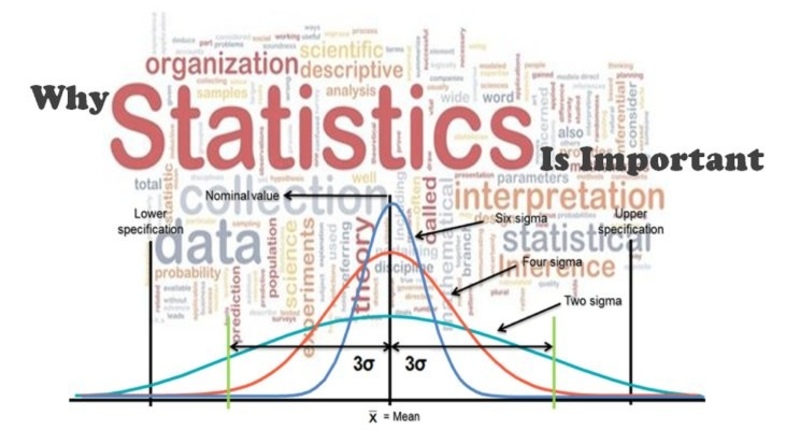Your Complete Guide to Statistics
May 18, 2024 By Susan Kelly
Statistics is important in many fields for understanding and explaining data. It involves gathering, arranging, examining, interpreting, and displaying numerical information. In the heart of statistics lies the task of comprehending a complicated array of data sets thus allowing intelligent decision-making in all sectors including industrial as well as academic settings. In this thorough explanation, we look into the meaning, kinds, and crucial significance of statistics.
1. The Definition of Statistics
The word "statistics" means the study of how to gather, sort out, examine, and explain numerical facts. It includes ways to collect information through watching or trying things, then using maths and computer methods to understand these details in a useful way. Statistics gives us rules for seeing patterns, changes over time, and connections between different sets of information, revealing important understandings about all sorts of things.

Statistics is a crucial part of decision-making, offering a structured method for solving problems and checking hypotheses. It allows researchers, analysts, and people who make policies to measure uncertainties, spot important patterns, and gauge how trustworthy data is. In addition to this, statistics promotes teamwork between different disciplines by giving them one language to communicate findings and draw conclusions.
- Data Transformation: Statistics allows for transforming raw data into actionable insights through techniques such as normalization, scaling, and transformation.
- Data Quality Assurance: Statistical methods are employed to assess the quality and reliability of data, ensuring accuracy and validity in analysis and interpretation.
2. Descriptive Statistics
Description statistics means to summarize and show data in a useful way. It contains values like average, middle value (median), most frequent value (mode), standard difference (deviation) and span (range). These help to explain the center tendency, scatterness as well as how data is distributed. Description statistics give a quick look at the features of a group of data, making it easy to understand its properties without going into more complex inferential analysis.
Apart from the usual methods, descriptive statistics also include graphic displays like histograms, box plots, and scatter plots. These visuals make data easier to understand by showing patterns, odd points, and connections. The combination of numerical summaries with graphical displays provides a complete picture of data distribution and spread, helping in the exploratory analysis of data as well as creating hypotheses.
- Data Visualization: Descriptive statistics utilize graphical representations to convey information effectively, enhancing data interpretation and communication.
- Summary Statistics: Beyond basic measures, descriptive statistics encompass a range of summary statistics tailored to specific data types and distributions, such as quartiles, percentiles, and skewness.
3. Inferential Statistics
Inferential statistics is about making conclusions or forecasts of a population's characteristics using data from a sample. It uses probability theory and hypothesis testing to make inferences about relationships, trends, or effects within the larger population that the sample is taken from. By extending understanding from example data to a wider population, inferential statistics helps in the decision-making process and making predictions across different areas of study.
Moreover, inferential statistics includes various methods like regression analysis, analysis of variance (ANOVA), and chi-square tests. These techniques allow researchers to measure the importance of relationships, compare group averages, and assess how strong associations are within data sets. By giving a numerical value to uncertainty and making approximations about parameters, inferential statistics help people who make decisions by using limited sample information for smart choices or conclusions that can be trusted.
- Sampling Techniques: Inferential statistics relies on various sampling methods, such as random sampling, stratified sampling, and cluster sampling, to ensure representative and unbiased samples.
- Confidence Intervals: In addition to point estimates, inferential statistics provides confidence intervals to quantify the uncertainty surrounding population parameters, offering insights into the precision of estimates.
4. The Importance of Statistics

Statistics are needed in many areas of study, like economics, sociology, psychology, medicine, and business. By giving numbers-based understanding, statistics helps those who make decisions to create strategies and policies as well as actions based on facts rather than just personal feelings or guesses. Also in research attempts, statistics assists with the structure of experiments for gathering information sets along with their examination and result explanation. In this way, it aids in pushing ahead scientific knowledge and comprehension. With the help of statistics, we can make predictions about future trends, possibilities, and results. This is known as predictive modeling or time-series analysis. Such methods are valuable for businesses, governments, and other groups to plan and handle risks.
In different areas, statistics functions as a method to measure performance, judge results, and observe the progress made toward goals. This helps make sure there's responsibility and effectiveness in healthcare services, public policies, and social sciences. In the health care field as well as the public policy area or social science realm - where we find evidence-based practice being used for guiding interventions; where formulation of policies happens based on what is found from data collection efforts along with research findings; also when it comes to evaluating programs considering real facts rather than assumptions-, statistics plays an important role here too. Through its ability to reveal patterns in data, relationships between variables, and trends over time - statistics promotes innovation across many domains such as science or technology which rely on numbers-driven processes like modeling complex systems using equations.
- Ethical Considerations: Statistics necessitates ethical considerations regarding data privacy, confidentiality, and informed consent, ensuring responsible and transparent conduct in research and analysis.
- Causal Inference: While statistics can reveal associations between variables, caution must be exercised in inferring causality, as correlation does not imply causation.
Conclusion
To finish, statistics is like a basic block for making decisions based on data in today's time. It provides an important understanding of the complicated things around us. By defining it, looking at its different kinds, and realizing how crucial it is, people and groups can use statistics to handle uncertainties, find solutions for problems, and push forward on an ever more data-focused planet.

The Impact of Fed Tapering on the Markets
The Fed usually tries to raise interest rates to cool it down. Like this, when the economy is doing poorly, the Fed will often lower interest rates to boost activity. The takeaway from his research, in either instance, is that factors other than interest rates are more important in determining stock market prices
Feb 24, 2024 Triston Martin

Review of American Express's Plum Card for 2022
To help you make better financial decisions, Bankrate is here. This post may include links to items from our business partners, but we take editorial integrity very seriously. Here's a breakdown of how we generate revenue. Even though the information on this page was correct at the time of publication, some of the deals featured here may have since expired. The deals on this website are subject to terms and conditions.
Jan 26, 2024 Triston Martin

What You Need To Know Before Putting Your Money In A Bond Mutual Fund
Mutual funds that invest primarily in fixed income instruments, such as bonds or mortgage-backed securities, are known as "fixed income funds." Government bonds and debentures are common types of debt securities. We shall refer to the debt instruments as "government bonds" if the government issues them.
Dec 08, 2023 Triston Martin

What Does Annual Exclusion Mean?
Gifts to individuals are subject to gift tax and might reduce an individual's unified credit if they exceed the annual exclusion amount. An annual allowance for presents can be made in the form of money or property. The Internal Revenue Service has verified that the annual exclusion would remain at $15k in 2021.
Dec 18, 2023 Susan Kelly

Exploring the Cutting-Edge Role of AI in Finance: 7 Transformative Examples
7 transformative examples of AI in finance in 2024. Explore how artificial intelligence is reshaping financial services, from risk management to personalized banking
Sep 12, 2024 Sid Leonard

529Plan Made Simple: Your Guide to College Savings
Find how to save for college effortlessly with our comprehensive guide to 529 plans and college savings strategies.
Mar 13, 2024 Susan Kelly